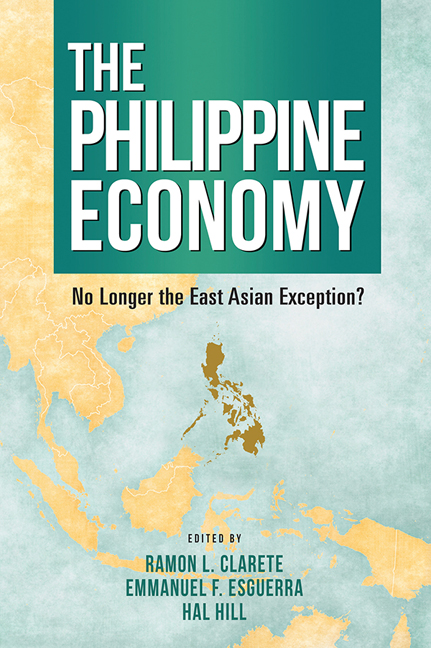Book contents
- Frontmatter
- Contents
- List of Figures
- List of Tables
- Foreword by Arsenio M. Balisacan
- Preface
- About the Contributors
- 1 The Philippine Economy: An Overview
- 2 Economic Growth and Poverty Reduction
- 3 Infrastructure and Urbanization
- 4 Education and Training
- 5 Universal Health Coverage, Health Security and Resilient Health Systems
- 6 Environmental Resources, Shocks and National Well-Being
- 7 Energy: Power Security and Competitiveness
- 8 Development Finance
- 9 Governance and Institutions
- Index
7 - Energy: Power Security and Competitiveness
Published online by Cambridge University Press: 12 February 2019
- Frontmatter
- Contents
- List of Figures
- List of Tables
- Foreword by Arsenio M. Balisacan
- Preface
- About the Contributors
- 1 The Philippine Economy: An Overview
- 2 Economic Growth and Poverty Reduction
- 3 Infrastructure and Urbanization
- 4 Education and Training
- 5 Universal Health Coverage, Health Security and Resilient Health Systems
- 6 Environmental Resources, Shocks and National Well-Being
- 7 Energy: Power Security and Competitiveness
- 8 Development Finance
- 9 Governance and Institutions
- Index
Summary
According to one set of official projections, if the Philippine economy were to grow at 7 per cent per annum, close to the rate achieved in recent years, then by 2040 the country's per capita income would be P316, 173 ($6,873) at constant 2000 prices — a sharp increase from the 2015 level of P74, 453 ($1,618). This is an optimistic forecast, given that annual per capita income growth over the past twenty-five years averaged only about 2 per cent. The impressive growth attained during the period 2011–16 was mainly driven by private and government consumption, which was, in turn, partly fuelled by overseas Filipinos’ remittances (BSP 2015).
The sustainability of the recent growth remains tenuous. One constraint is the perennially high cost of power, as well as an inadequate power supply that cannot support the country's potential growth. The challenge lies in both the sourcing and timing of additional power supply to meet the growing demand and avert a recurrence of the power crisis that took place in the early 1990s, while also reducing the cost of power. Energy supply and cost are central to an improved investment climate that in turn generates a higher productivity growth.
Philippine power costs are high by regional standards; within the Association of Southeast Asian Nations (ASEAN), it ranks second to Singapore. Thus, the country struggles to attract mobile capital, a reason why manufacturing growth has lagged in recent decades. We have elsewhere labelled the slower manufacturing growth compared to services as “development progeria” (Daway and Fabella 2015), where services forge ahead to developed-country levels in low-income countries. This translates into slow growth and slow poverty reduction.
Republic Act (RA) 9136, otherwise known as the Electric Power Industry Reform Act (EPIRA) of 2001, has the well-intentioned objective of opening up access to, and fostering competition in, the retailing of electricity so as to lower the price for consumers. However, electricity prices in the Philippines remain among the highest in Southeast Asia. Figure 7.1 shows the trends in electricity tariffs for residential and industrial customers in selected Asian economies. In 2013, for example, the Philippines’ residential rate was $0.14/kWh, much higher than the rate in Singapore ($0.12/kWh), Thailand ($0.08/kWh), Indonesia ($0.04/kWh), and Malaysia ($0.06/kWh). While the Philippines’ industrial rate ($0.10/kWh) was a close second to the highest rate in Singapore ($0.11/kWh).
- Type
- Chapter
- Information
- The Philippine EconomyNo Longer The East Asian Exception?, pp. 269 - 323Publisher: ISEAS–Yusof Ishak InstitutePrint publication year: 2018

